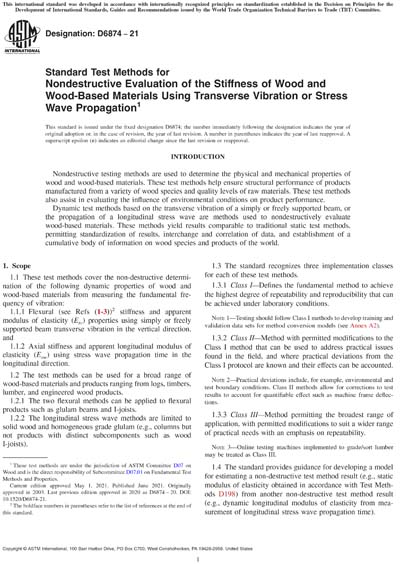Historical
ASTM D6874-21
Standard Test Methods for Nondestructive Evaluation of the Stiffness of Wood and Wood-Based Materials Using Transverse Vibration or Stress Wave Propagation
1.1These test methods cover the non-destructive determination of the following dynamic properties of wood and wood-based materials from measuring the fundamental frequency of vibration:
1.1.1Flexural (see Refs (1-3))2 stiffness and apparent modulus of elasticity (Etv) properties using simply or freely supported beam transverse vibration in the vertical direction, and
1.1.2Axial stiffness and apparent longitudinal modulus of elasticity (Esw) using stress wave propagation time in the longitudinal direction.
1.2The test methods can be used for a broad range of wood-based materials and products ranging from logs, timbers, lumber, and engineered wood products.
1.2.1The two flexural methods can be applied to flexural products such as glulam beams and I-joists.
1.2.2The longitudinal stress wave methods are limited to solid wood and homogeneous grade glulam (e.g., columns but not products with distinct subcomponents such as wood I-joists).
1.3The standard recognizes three implementation classes for each of these test methods.
1.3.1Class I - Defines the fundamental method to achieve the highest degree of repeatability and reproducibility that can be achieved under laboratory conditions.
Note 1:Testing should follow Class I methods to develop training and validation data sets for method conversion models (see Annex A2).
1.3.2Class II - Method with permitted modifications to the Class I method that can be used to address practical issues found in the field, and where practical deviations from the Class I protocol are known and their effects can be accounted.
Note 2:Practical deviations include, for example, environmental and test boundary conditions. Class II methods allow for corrections to test results to account for quantifiable effect such as machine frame deflections.
1.3.3Class III - Method permitting the broadest range of application, with permitted modifications to suit a wider range of practical needs with an emphasis on repeatability.
Note 3:Online testing machines implemented to grade/sort lumber may be treated as Class III.
1.4The standard provides guidance for developing a model for estimating a non-destructive test method result (e.g., static modulus of elasticity obtained in accordance with Test Methods D198) from another non-destructive test method result (e.g., dynamic longitudinal modulus of elasticity from measurement of longitudinal stress wave propagation time).
1.4.1The standard covers only models developed from test data obtained directly from non-destructively testing a representative sample using one test method, and retesting the same sample following a second test method.
1.4.2Results used for model development shall not be estimated from a model.
1.5The values stated in inch-pound units are to be regarded as standard. The values given in parentheses are mathematical conversions to SI units that are provided for information only and are not considered standard.
1.6This standard does not purport to address all of the safety concerns, if any, associated with its use. It is the responsibility of the user of this standard to establish appropriate safety, health, and environmental practices and determine the applicability of regulatory limitations prior to use.
1.7This international standard was developed in accordance with internationally recognized principles on standardization established in the Decision on Principles for the Development of International Standards, Guides and Recommendations issued by the World Trade Organization Technical Barriers to Trade (TBT) Committee.
Content Provider
ASTM International [astm]






